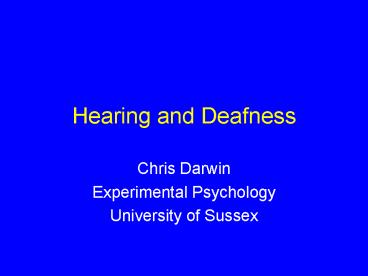Hearing and Deafness PowerPoint PPT Presentation
1 / 23
Title: Hearing and Deafness
1
Hearing and Deafness
- Chris Darwin
- Experimental Psychology
- University of Sussex
2
Outer, middle and inner ear
3
Types of hearing loss - 1
- 1. Conductive Hearing Loss
- defect in the external or middle ear sound not
getting into inner ear - severe hearing loss up to 60 dB (talking)
- can interfere with language development
- middle ear effusions
- mild loss up to 30 dB (whisper)
4
Cochlea cross-section
5
Organ of Corti
6
Organ of Corti in action
7
Reponse of basilar membraneto sine waves
Each point on the membrane acts like bandpass
filter tuned to a different frequency high freq
at base, low at apex. Each point vibrates at
frequency of pure tone (-gt phase locking)
8
Reponse of basilar membraneto sine waves
Each point on the membrane acts like bandpass
filter tuned to a different frequency high freq
at base, low at apex. Each point vibrates at
frequency of pure tone (-gt phase locking)
9
Outer Hair cell
10
Types of hearing loss - 2
- Sensori-neural (SNHL)
- Outer-hair cell damage (and inner) from
cumulative exposure to loud sound - Breakdown of cochlear frequency analysis
- Only partial help from hearing aids
11
Symptoms of SNHL(from OHC loss)
- Raised thresholds
- helped by amplification
- Wider bandwidths
- no help possible
- Recruitment (restricted dynamic range)
- partly helped by automatic gain controls in
modern digital aids - Often accompanied by tinnitus
12
Conductive vs Sensori-neural deafness
Mostly a combination of OHC and IHC damage
13
Normal vs Impaired Hearing
14
Demo of hearing loss
from "Perceptual consequences of cochlear damage"
by Brian C J Moore. OUP 1995.
Normal
SNHL sloping loss mild at low frequencies severe
at high frequencies
15
Excitation pattern of complex tone on bm
16
Cochlear excitation patterns
Normal
Bandwidths three times broader
17
Levels of hearing loss
- Loss of hearing ranging from
- mild (lt60 dB), to
- severe (60-80 dB), to
- profound (gt85 dB).
- prevalence 1/1000 children (severe to profound
hearing loss) - incidence 1/1000 babies born deaf
- 1/50 infants from an NICU have significant
hearing loss - 1/10 children develop hearing problems at some
time
18
Effects of SNHL on speech
- Speech very redundant
- High-pass 1400Hz Low-pass 1400 Hz
- High frequencies most affected
- prosodic features best (pitch given by low freqs)
- consonants worse than vowels
- lip-reading helps place information in consonants
- Wider bandwidths -gt more masking
19
Suitability for implant
Over 2 years of age Profound hearing loss in
both ears Does not benefit from conventional
hearing aids Has strong desire to communicate
20
Cochlear Implant
1. Mic. 2.Lead 3. speech processor. 4 the
transmitting coil 5. Transmitting coil sends the
signals transdermally to the implanted
receiver/stimulator via an FM radio signal. 6.
The receiver stimulator 7. The electrodes along
the array stimulate the remaining auditory nerve
fibers in the cochlea. 8. auditory nerve
21
Cochlear implant 2
22
ShannonImplantDemo
23
Types of hearing loss
3. Cortical Hearing Loss inadequate
transmission of the neural impulses from the
inner ear to the temporal lobes associated
with diseases of the White Matter results in
several different types of hearing loss 1.
Cortical Deafness affects perception of all
sounds 2. Cortical Agnosia affects perception
of environmental sounds 3. Verbal Auditory
Agnosia affects perception of language and
results in severe receptive dysphasia

